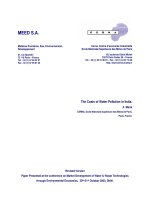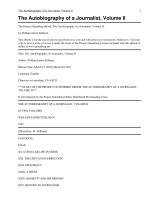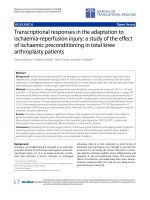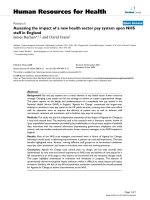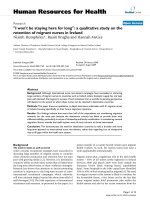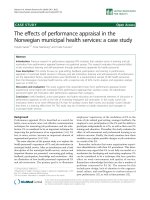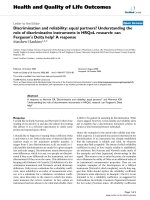genome the autobiography of a species in 23 chapters - matt ridley
Bạn đang xem bản rút gọn của tài liệu. Xem và tải ngay bản đầy đủ của tài liệu tại đây (1.42 MB, 349 trang )
The author is grateful to the following publishers for permission to
reprint brief extracts: Harvard University Press for four extracts from
Nancy Wexler's article in The Code of Codes, edited by D. Kevles and
R. Hood (pp. 62-9); Aurum Press for an extract from The Gene
Hunters by William Cookson (p. 78); Macmillan Press for extracts from
Philosophical Essays by A. J. Ayer (p. 338) and What Remains to Be
Discovered by J. Maddox (p. 194); W. H. Freeman for extracts from
The Narrow Roads of Gene Land by W. D. Hamilton (p. 131); Oxford
University Press for extracts from The Selfish Gene by Richard Dawkins
(p. 122) and Fatal Protein by Rosalind Ridley and Harry Baker (p. 285);
Weidenfeld and Nicolson for an extract from One Renegade Cell by
Robert Weinberg (p. 237). The author has made every effort to obtain
permission for all other extracts from published work reprinted in this
book.
This book was originally published in Great Britain in 1999 by Fourth
Estate Limited.
GENOME. Copyright © 1999 by Matt Ridley. All rights reserved. Printed
in the United States of America. No part of this book may be used or
reproduced in any manner whatsoever without written permission
except in the case of brief quotations embodied in critical articles and
reviews. For information address HarperCollins Publishers, Inc., 10
East 53rd Street, New York, NY 10022.
HarperCollins books may be purchased for educational, business, or
sales promotional use. For information please write: Special Markets
Department, HarperCollins Publishers, Inc., 10 East 53rd Street, New
York, NY 10022.
FIRST U.S. EDITION
Library of Congress Cataloging-in-Publication Data
Ridley, Matt
Genome: the autobiography of a species in 23 chapters/Matt Ridley.
p. cm.
Includes bibliographical references and index.
ISBN
0-06-019497-9
1. Human genome Popular works. 2. Human genetics Popular
works. I. Title.
QH431.R475 2000
599.93'5—dc21 99-40933
00
01
02
03
04
RRD 10
9 8 7 6 5 4 3 2 1
CONTENTS
Acknowledgements l
Preface 3
1 Life 11
2 Species 23
3 History 38
4 Fate 54
5 Environment 65
6 Intelligence 76
7 Instinct 91
X and Y Conflict 107
8 Self-interest 122
9 Disease 136
10 Stress 147
11 Personality 161
12 Self-Assembly 173
13 Pre-History 185
14 Immortality 195
15 Sex 206
16 Memory 219
17 Death 231
18 Cures 243
19 Prevention 258
20 Politics 271
21 Eugenics 286
22 Free Will 301
Bibliography and Notes 314
Index 337
ALSO BY MATT RIDLEY
The Red Queen: Sex and the Evolution of Human Nature
The Origins of Virtue:
Human Instincts and the Evolution of Cooperation
ACKNOWLEDGEMENTS
In writing this book, I have disturbed, interrupted, interrogated,
emailed and corresponded with a great variety of people, yet I have
never once met anything but patience and politeness. I cannot thank
everybody by name, but I would like to record my great debts of
gratitude to the following: Bill Amos, Rosalind Arden, Christopher
Badcock, Rosa Beddington, David Bendey, Ray Blanchard, Sam
Brittan, John Burn, Francis Crick, Gerhard Cristofori, Paul Davies,
Barry Dickson, Richard Durbin, Jim Edwardson, Myrna Gopnik,
Anthony Gottlieb, Dean Hamer, Nick Hastie, Brett Holland, Tony
Ingram, Mary James, Harmke Kamminga, Terence Kealey, Arnold
Levine, Colin Merritt, Geoffrey Miller, Graeme Mitchison, Anders
Moller, Oliver Morton, Kim Nasmyth, Sasha Norris, Mark Pagel,
Rose Paterson, David Penny, Marion Petrie, Steven Pinker, Robert
Plomin, Anthony Poole, Christine Rees, Janet Rossant, Mark Ridley,
Robert Sapolsky, Tom Shakespeare, Ancino Silva, Lee Silver, Tom
Strachan, John Sulston, Tim Tully, Thomas Vogt, Jim Watson, Eric
Wieschaus and Ian Wilmut.
Special thanks to all my colleagues at the International Centre for
Life, where we have been trying to bring the genome to life. Without
the day-to-day interest and support from them in matters biological
2 GENOME
and genetic, I doubt I could have written this book. They are Alastair
Balls, John Burn, Linda Conlon, Ian Fells, Irene Nyguist, Neil Sulli-
van, Elspeth Wills and many others.
Parts of two chapters first appeared in newspaper columns and
magazine articles. I am grateful to Charles Moore of the Daily Tele-
graph and David Goodhart of Prospect for publishing them.
My agent, Felicity Bryan, has been enthusiasm personified
throughout. Three editors had more faith in this book when it was
just a proposal than (I now admit) I did: Christopher Potter, Marion
Manneker and Maarten Carbo.
But to one person I give deeper and more heartfelt gratitude than
to all the rest put together: my wife, Anya Hurlbert.
PREFACE
The human genome — the complete set of human genes - comes
packaged in twenty-three separate pairs of chromosomes. Of these,
twenty-two pairs are numbered in approximate order of size, from
the largest (number 1) to the smallest (number 22), while the remain-
ing pair consists of the sex chromosomes: two large X chromosomes
in women, one X and one small Y in men. In size, the X comes
between chromosomes 7 and 8, whereas the Y is the smallest.
The number 23 is of no significance. Many species, including our
closest relatives among the apes, have more chromosomes, and
many have fewer. Nor do genes of similar function and type neces-
sarily cluster on the same chromosome. So a few years ago, leaning
over a lap-top computer talking to David Haig, an evolutionary
biologist, I was slightly startled to hear him say that chromosome
19 was his favourite chromosome. It has all sorts of mischievous
genes on it, he explained. I had never thought of chromosomes
as having personalities before. They are, after all, merely arbitrary
collections of genes. But Haig's chance remark planted an idea in
my head and I could not get it out. Why not try to tell the unfolding
story of the human genome, now being discovered in detail for the
first time, chromosome by chromosome, by picking a gene from
4 GENOME
each chromosome to fit the story as it is told? Primo Levi did
something similar with the periodic table of the elements in his
autobiographical short stories. He related each chapter of his life to
an element, one that he had had some contact with during the
period he was describing.
I began to think about the human genome as a sort of autobiog-
raphy in its own right — a record, written in 'genetish', of all the
vicissitudes and inventions that had characterised the history of our
species and its ancestors since the very dawn of life. There are
genes that have not changed much since the very first single-celled
creatures populated the primeval ooze. There are genes that were
developed when our ancestors were worm-like. There are genes that
must have first appeared when our ancestors were fish. There are
genes that exist in their present form only because of recent epi-
demics of disease. And there are genes that can be used to write
the history of human migrations in the last few thousand years.
From four billion years ago to just a few hundred years ago, the
genome has been a sort of autobiography for our species, recording
the important events as they occurred.
I wrote down a list of the twenty-three chromosomes and next
to each I began to list themes of human nature. Gradually and
painstakingly I began to find genes that were emblematic of my
story. There were frequent frustrations when I could not find a
suitable gene, or when I found the ideal gene and it was on the
wrong chromosome. There was the puzzle of what to do with the
X and Y chromosomes, which I have placed after chromosome 7,
as befits the X chromosome's size. You now know why the last
chapter of a book that boasts in its subtitle that it has twenty-three
chapters is called Chapter 22.
It is, at first glance, a most misleading thing that I have done. I
may seem to be implying that chromosome 1 came first, which it
did not. I may seem to imply that chromosome 11 is exclusively
concerned with human personality, which it is not. There are prob-
ably 60,000—80,000 genes in the human genome and I could not
tell you about all of them, partly because fewer than 8,000 have
PREFACE 5
been found (though the number is growing by several hundred a
month) and partly because the great majority of them are tedious
biochemical middle managers.
But what I can give you is a coherent glimpse of the whole: a
whistle-stop tour of some of the more interesting sites in the genome
and what they tell us about ourselves. For we, this lucky generation,
will be the first to read the book that is the genome. Being able to
read the genome will tell us more about our origins, our evolution,
our nature and our minds than all the efforts of science to date. It
will revolutionise anthropology, psychology, medicine, palaeontology
and virtually every other science. This is not to claim that everything
is in the genes, or that genes matter more than other factors. Clearly,
they do not. But they matter, that is for sure.
This is not a book about the Human Genome Project — about
mapping and sequencing techniques - but a book about what that
project has found. Some time in the year 2000, we shall probably
have a rough first draft of the complete human genome. In just a
few short years we will have moved from knowing almost nothing
about our genes to knowing everything. I genuinely believe that we
are living through the greatest intellectual moment in history. Bar
none. Some may protest that the human being is more than his
genes. I do not deny it. There is much, much more to each of us
than a genetic code. But until now human genes were an almost
complete mystery. We will be the first generation to penetrate that
mystery. We stand on the brink of great new answers but, even
more, of great new questions. This is what I have tried to convey
in this book.
PRIMER
The second part of this preface is intended as a brief primer, a sort
of narrative glossary, on the subject of genes and how they work.
I hope that readers will glance through it at the outset and return
to it at intervals if they come across technical terms that are not
explained. Modern genetics is a formidable thicket of jargon. I have
6 GENOME
tried hard to use the bare minimum of technical terms in this book,
but some are unavoidable.
The human body contains approximately 100 trillion (million mil-
lion) CELLS, most of which are less than a tenth of a millimetre
across. Inside each cell there is a black blob called a NUCLEUS.
Inside the nucleus are two complete sets of the human
GENOME
(except in egg cells and sperm cells, which have one copy each, and
red blood cells, which have none). One set of the genome came
from the mother and one from the father. In principle, each set
includes the same 60,000-80,000
GENES
on the same twenty-three
CHROMOSOMES.
In practice, there are often small and subtle differ-
ences between the paternal and maternal versions of each gene,
differences that account for blue eyes or brown, for example. When
we breed, we pass on one complete set, but only after swapping
bits of the paternal and maternal chromosomes in a procedure
known as
RECOMBINATION.
Imagine that the genome is a book.
There are twenty-three chapters, called
CHROMOSOMES.
Each chapter contains several thousand stories, called GENES.
Each story is made up of paragraphs, called EXONS, which are interrupted
by advertisements called INTRONS.
Each paragraph is made up of words, called CODONS.
Each word is written in letters called BASES.
There are one billion words in the book, which makes it longer
than 5,000 volumes the size of this one, or as long as 800 Bibles.
If I read the genome out to you at the rate of one word per second
for eight hours a day, it would take me a century. If I wrote out
the human genome, one letter per millimetre, my text would be as
long as the River Danube. This is a gigantic document, an immense
book, a recipe of extravagant length, and it all fits inside the micro-
scopic nucleus of a tiny cell that fits easily upon the head of a pin.
The idea of the genome as a book is not, strictly speaking, even
a metaphor. It is literally true. A book is a piece of digital information,
PREFACE
7
written in linear, one-dimensional and one-directional form and
defined by a code that transliterates a small alphabet of signs into
a large lexicon of meanings through the order of their groupings.
So is a genome. The only complication is that all English books
read from left to right, whereas some parts of the genome read
from left to right, and some from right to left, though never both
at the same time.
(Incidentally, you will not find the tired word 'blueprint' in this
book, after this paragraph, for three reasons. First, only architects
and engineers use blueprints and even they are giving them up in
the computer age, whereas we all use books. Second, blueprints are
very bad analogies for genes. Blueprints are two-dimensional maps,
not one-dimensional digital codes. Third, blueprints are too literal
for genetics, because each part of a blueprint makes an equivalent
part of the machine or building; each sentence of a recipe book
does not make a different mouthful of cake.)
Whereas English books are written in words of variable length
using twenty-six letters, genomes are written entirely in three-letter
words, using only four letters: A, C, G and T (which stand for
adenine, cytosine, guanine and thymine). And instead of being writ-
ten on flat pages, they are written on long chains of sugar and
phosphate called DNA molecules to which the bases are attached
as side rungs. Each chromosome is one pair of (very) long DNA
molecules.
The genome is a very clever book, because in the right conditions
it can both photocopy itself and read itself. The photocopying is
known as REPLICATION, and the reading as TRANSLATION. Rep-
lication works because of an ingenious property of the four bases:
A likes to pair with T, and G with C. So a single strand of DNA
can copy itself by assembling a complementary strand with Ts oppos-
ite all the As, As opposite all the Ts, Cs opposite all the Gs and
Gs opposite all the Cs. In fact, the usual state of DNA is the famous
DOUBLE HELIX of the original strand and its complementary pair
intertwined.
To make a copy of the complementary strand therefore brings
8 GENOME
back the original text. So the sequence ACGT become TGCA in
the copy, which transcribes back to ACGT in the copy of the copy.
This enables DNA to replicate indefinitely, yet still contain the
same information.
Translation is a little more complicated. First the text of a gene
is TRANSCRIBED into a copy by the same base-pairing process,
but this time the copy is made not of DNA but of RNA, a very
slightly different chemical. RNA, too, can carry a linear code and
it uses the same letters as DNA except that it uses U, for uracil,
in place of T. This RNA copy, called the MESSENGER RNA, is
then edited by the excision of all introns and the splicing together
of all exons (see above).
The messenger is then befriended by a microscopic machine called
a RIBOSOME, itself made partly of RNA. The ribosome moves
along the messenger, translating each three-letter codon in turn into
one letter of a different alphabet, an alphabet of twenty different
AMINO ACIDS, each brought by a different version of a molecule
called TRANSFER RNA. Each amino acid is attached to the last to
form a chain in the same order as the codons. When the whole
message has been translated, the chain of amino acids folds itself
up into a distinctive shape that depends on its sequence. It is now
known as a PROTEIN.
Almost everything in the body, from hair to hormones, is either
made of proteins or made by them. Every protein is a translated
gene. In particular, the body's chemical reactions are catalysed by
proteins known as ENZYMES. Even the processing, photocopying
error-correction and assembly of DNA and RNA molecules them-
selves — the replication and translation - are done with the help
of proteins. Proteins are also responsible for switching genes on
and off, by physically attaching themselves to PROMOTER and
ENHANCER sequences near the start of a gene's text. Different
genes are switched on in different parts of the body.
When genes are replicated, mistakes are sometimes made. A letter
(base) is occasionally missed out or the wrong letter inserted. Whole
sentences or paragraphs are sometimes duplicated, omitted or
PREFACE 9
reversed. This is known as
MUTATION.
Many mutations are neither
harmful nor beneficial, for instance if they change one codon to
another that has the same amino acid 'meaning': there are sixty-four
different codons and only twenty amino acids, so many DNA
'words' share the same meaning. Human beings accumulate about
one hundred mutations per generation, which may not seem much
given that there are more than a million codons in the human
genome, but in the wrong place even a single one can be fatal.
All rules have exceptions (including this one). Not all human
genes are found on the twenty-three principal chromosomes; a few
live inside little blobs called mitochondria and have probably done
so ever since mitochondria were free-living bacteria. Not all genes
are made of DNA: some viruses use RNA instead. Not all genes
are recipes for proteins. Some genes are transcribed into RNA but
not translated into protein; the RNA goes direcdy to work instead
either as part of a ribosome or as a transfer RNA. Not all reactions
are catalysed by proteins; a few are catalysed by RNA instead. Not
every protein comes from a single gene; some are put together from
several recipes. Not all of the sixty-four three-letter codons specifies
an amino acid: three signify STOP commands instead. And finally,
not all DNA spells out genes. Most of it is a jumble of repetitive
or random sequences that is rarely or never transcribed: the so-called
junk DNA.
That is all you need to know. The tour of the human genome
can begin.
CHROMOSOME 1
Life
All forms that perish other forms supply,
(By turns we catch the vital breath and die)
Like bubbles on the sea of matter borne,
They rise, they break, and to that sea return.
Alexander Pope, An Essay on Man
In the beginning was the word. The word proselytised the sea with
its message, copying itself unceasingly and forever. The word dis-
covered how to rearrange chemicals so as to capture little eddies in
the stream of entropy and make them live. The word transformed
the land surface of the planet from a dusty hell to a verdant paradise.
The word eventually blossomed and became sufficiently ingenious
to build a porridgy contraption called a human brain that could
discover and be aware of the word itself.
My porridgy contraption boggles every time I think this thought.
In four thousand million years of earth history, I am lucky enough
to be alive today. In five million species, I was fortunate enough to
be born a conscious human being. Among six thousand million
people on the planet, I was privileged enough to be born in the
12 GENOME
country where the word was discovered. In all of the earth's history,
biology and geography, I was born just five years after the moment
when, and just two hundred miles from the place where, two
members of my own species discovered the structure of DNA and
hence uncovered the greatest, simplest and most surprising secret
in the universe. Mock my zeal if you wish; consider me a ridiculous
materialist for investing such enthusiasm in an acronym. But follow
me on a journey back to the very origin of life, and I hope I can
convince you of the immense fascination of the word.
'As the earth and ocean were probably peopled with vegetable
productions long before the existence of animals; and many families
of these animals long before other families of them, shall we conjec-
ture that one and the same kind of living filaments is and has been
the cause of all organic life?' asked the polymathic poet and physician
Erasmus Darwin in 1794.
1
It was a startling guess for the time, not
only in its bold conjecture that all organic life shared the same origin,
sixty-five years before his grandson Charles' book on the topic, but
for its weird use of the word 'filaments'. The secret of life is indeed
a thread.
Yet how can a filament make something live? Life is a slippery
thing to define, but it consists of two very different skills: the ability
to replicate, and the ability to create order. Living things produce
approximate copies of themselves: rabbits produce rabbits, dan-
delions make dandelions. But rabbits do more than that. They eat
grass, transform it into rabbit flesh and somehow build bodies of
order and complexity from the random chaos of the world. They
do not defy the second law of thermodynamics, which says that in a
closed system everything tends from order towards disorder, because
rabbits are not closed systems. Rabbits build packets of order and
complexity called bodies but at the cost of expending large amounts
of energy. In Erwin Schrodinger's phrase, living creatures 'drink
orderliness' from the environment.
The key to both of these features of life is information. The
ability to replicate is made possible by the existence of a recipe, the
information that is needed to create a new body. A rabbit's egg
LIFE 13
carries the instructions for assembling a new rabbit. But the ability
to create order through metabolism also depends on information -
the instructions for building and maintaining the equipment that
creates the order. An adult rabbit, with its ability to both reproduce
and metabolise, is prefigured and presupposed in its living filaments
in the same way that a cake is prefigured and presupposed in its
recipe. This is an idea that goes right back to Aristotle, who said
that the 'concept' of a chicken is implicit in an egg, or that an acorn
was literally 'informed' by the plan of an oak tree. When Aristotle's
dim perception of information theory, buried under generations of
chemistry and physics, re-emerged amid the discoveries of modern
genetics, Max Delbruck joked that the Greek sage should be given
a posthumous Nobel prize for the discovery of DNA.
2
The filament of DNA is information, a message written in a code
of chemicals, one chemical for each letter. It is almost too good to be
true, but the code turns out to be written in a way that we can under-
stand. Just like written English, the genetic code is a linear language,
written in a straight line. Just like written English, it is digital, in that
every letter bears the same importance. Moreover, the language of
DNA is considerably simpler than English, since it has an alphabet
of only four letters, conventionally known as A, C, G and T.
Now that we know that genes are coded recipes, it is hard to
recall how few people even guessed such a possibility. For the first
half of the twentieth century, one question reverberated unanswered
through biology: what is a gene? It seemed almost impossibly mys-
terious. Go back not to 1953, the year of the discovery of DNA's
symmetrical structure, but ten years further, to 1943. Those who
will do most to crack the mystery, a whole decade later, are working
on other things in 1943. Francis Crick is working on the design of
naval mines near Portsmouth. At the same time James Watson is
just enrolling as an undergraduate at the precocious age of fifteen
at the University of Chicago; he is determined to devote his life to
ornithology. Maurice Wilkins is helping to design the atom bomb
in the United States. Rosalind Franklin is studying the structure of
coal for the British government.
14 GENOME
In Auschwitz in 1943, Josef Mengele is torturing twins to death
in a grotesque parody of scientific inquiry. Mengele is trying to
understand heredity, but his eugenics proves not to be the path to
enlightenment. Mengele's results will be useless to future scientists.
In Dublin in 1943, a refugee from Mengele and his ilk, the great
physicist Erwin Schrodinger is embarking on a series of lectures at
Trinity College entitled What is life?' He is trying to define a
problem. He knows that chromosomes contain the secret of life,
but he cannot understand how: 'It is these chromosomes . . . that
contain in some kind of code-script the entire pattern of the indi-
vidual's future development and of its functioning in the mature
state.' The gene, he says, is too small to be anything other than a
large molecule, an insight that will inspire a generation of scientists,
including Crick, Watson, Wilkins and Franklin, to tackle what sud-
denly seems like a tractable problem. Having thus come tantalisingly
close to the answer, though, Schrodinger veers off track. He thinks
that the secret of this molecule's ability to carry heredity lies in his
beloved quantum theory, and is pursuing that obsession down what
will prove to be a blind alley. The secret of life has nothing to do
with quantum states. The answer will not come from physics.
3
In New York in 1943, a sixty-six-year-old Canadian scientist,
Oswald Avery, is putting the finishing touches to an experiment
that will decisively identify DNA as the chemical manifestation of
heredity. He has proved in a series of ingenious experiments that a
pneumonia bacterium can be transformed from a harmless to a
virulent strain merely by absorbing a simple chemical solution. By
1943, Avery has concluded that the transforming substance, once
purified, is DNA. But he will couch his conclusions in such cautious
language for publication that few will take notice until much later.
In a letter to his brother Roy written in May 1943, Avery is only
slightly less cautious:
4
If we are right, and of course that's not yet proven, then it means that
nucleic acids [DNA] are not merely structurally important but functionally
active substances in determining the biochemical activities and specific
LIFE 15
characteristics of cells — and that by means of a known chemical substance
it is possible to induce predictable and hereditary changes in cells. That
is something that has long been the dream of geneticists.
Avery is almost there, but he is still thinking along chemical lines.
'All life is chemistry', said Jan Baptista van Helmont in 1648, guessing.
At least some life is chemistry, said Friedrich Wohler in 1828 after
synthesising urea from ammonium chloride and silver cyanide, thus
breaking the hitherto sacrosanct divide between the chemical and
biological worlds: urea was something that only living things had
produced before. That life is chemistry is true but boring, like saying
that football is physics. Life, to a rough approximation, consists of
the chemistry of three atoms, hydrogen, carbon and oxygen, which
between them make up ninety-eight per cent of all atoms in living
beings. But it is the emergent properties of life — such as heritability
- not the constituent parts that are interesting. Avery cannot con-
ceive what it is about DNA that enables it to hold the secret of
heritable properties. The answer will not come from chemistry.
In Bletchley, in Britain, in 1943, in total secrecy, a brilliant math-
ematician, Alan Turing, is seeing his most incisive insight turned
into physical reality. Turing has argued that numbers can compute
numbers. To crack the Lorentz encoding machines of the German
forces, a computer called Colossus has been built based on Turing's
principles: it is a universal machine with a modifiable stored program.
Nobody realises it at the time, least of all Turing, but he is probably
closer to the mystery of life than anybody else. Heredity is a modifi-
able stored program; metabolism is a universal machine. The recipe
that links them is a code, an abstract message that can be embodied
in a chemical, physical or even immaterial form. Its secret is that it
can cause itself to be replicated. Anything that can use the resources
of the world to get copies of itself made is alive; the most likely
form for such a thing to take is a digital message - a number, a
script or a word.
5
In New Jersey in 1943, a quiet, reclusive scholar named Claude
Shannon is ruminating about an idea he had first had at Princeton
l6 GENOME
a few years earlier. Shannon's idea is that information and entropy
are opposite faces of the same coin and that both have an intimate
link with energy. The less entropy a system has, the more information
it contains. The reason a steam engine can harness the energy from
burning coal and turn it into rotary motion is because the engine
has high information content — information injected into it by its
designer. So does a human body. Aristotie's information theory
meets Newton's physics in Shannon's brain. Like Turing, Shannon
has no thoughts about biology. But his insight is of more relevance
to the question of what is life than a mountain of chemistry and
physics. Life, too, is digital information written in DNA.
6
In the beginning was the word. The word was not DNA. That
came afterwards, when life was already established, and when it had
divided the labour between two separate activities: chemical work
and information storage, metabolism and replication. But DNA
contains a record of the word, faithfully transmitted through all
subsequent aeons to the astonishing present.
Imagine the nucleus of a human egg beneath the microscope.
Arrange the twenty-three chromosomes, if you can, in order of size,
the biggest on the left and the smallest on the right. Now zoom in
on the largest chromosome, the one called, for purely arbitrary
reasons, chromosome 1. Every chromosome has a long arm and a
short arm separated by a pinch point known as a centromere. On
the long arm of chromosome 1, close to the centromere, you will
find, if you read it carefully, that there is a sequence of 120 letters
- As, Cs, Gs and Ts - that repeats over and over again. Between
each repeat there lies a stretch of more random text, but the 120-
letter paragraph keeps coming back like a familiar theme tune, in
all more than 100 times. This short paragraph is perhaps as close
as we can get to an echo of the original word.
This 'paragraph' is a small gene, probably the single most active
gene in the human body. Its 120 letters are constantly being copied
into a short filament of RNA. The copy is known as 5S RNA. It
sets up residence with a lump of proteins and other RNAs, carefully
intertwined, in a ribosome, a machine whose job is to translate
LIFE 17
DNA recipes into proteins. And it is proteins that enable DNA
to replicate. To paraphrase Samuel Butler, a protein is just a gene's
way of making another gene; and a gene is just a protein's way of
making another protein. Cooks need recipes, but recipes also need
cooks. Life consists of the interplay of two kinds of chemicals:
proteins and DNA.
Protein represents chemistry, living, breathing, metabolism and
behaviour - what biologists call the phenotype. DNA represents
information, replication, breeding, sex - what biologists call the
genotype. Neither can exist without the other. It is the classic case
of chicken and egg: which came first, DNA or protein? It cannot
have been DNA, because DNA is a helpless, passive piece of
mathematics, which catalyses no chemical reactions. It cannot have
been protein, because protein is pure chemistry with no known way
of copying itself accurately. It seems impossible either that DNA
invented protein or vice versa. This might have remained a baffling
and strange conundrum had not the word left a trace of itself faintly
drawn on the filament of life. Just as we now know that eggs came
long before chickens (the reptilian ancestors of all birds laid eggs),
so there is growing evidence that RNA came before proteins.
RNA is a chemical substance that links the two worlds of DNA
and protein. It is used mainly in the translation of the message from
the alphabet of DNA to the alphabet of proteins. But in the way
it behaves, it leaves little doubt that it is the ancestor of both. RNA
was Greece to DNA's Rome: Homer to her Virgil.
RNA was the word. RNA left behind five little clues to its
priority over both protein and DNA. Even today, the ingredients
of DNA are made by modifying the ingredients of RNA, not by
a more direct route. Also DNA's letter Ts are made from RNA's
letter Us. Many modern enzymes, though made of protein, rely on
small molecules of RNA to make them work. Moreover, RNA,
unlike DNA and protein, can copy itself without assistance: give it
the right ingredients and it will stitch them together into a message.
Wherever you look in the cell, the most primitive and basic functions
require the presence of RNA. It is an RNA-dependent enzyme
l8 GENOME
that takes the message, made of RNA, from the gene. It is an
RNA-containing machine, the ribosome, that translates that mes-
sage, and it is a little RNA molecule that fetches and carries the
amino acids for the translation of the gene's message. But above
all, RNA — unlike DNA — can act as a catalyst, breaking up and
joining other molecules including RNAs themselves. It can cut
them up, join the ends together, make some of its own building
blocks, and elongate a chain of RNA. It can even operate on itself,
cutting out a chunk of text and splicing the free ends together again.
7
The discovery of these remarkable properties of RNA in the
early 1980s, made by Thomas Cech and Sidney Altman, transformed
our understanding of the origin of life. It now seems probable that
the very first gene, the 'ur-gene', was a combined replicator—catalyst,
a word that consumed the chemicals around it to duplicate itself. It
may well have been made of RNA. By repeatedly selecting random
RNA molecules in the test tube based on their ability to catalyse
reactions, it is possible to 'evolve' catalytic RNAs from scratch —
almost to rerun the origin of life. And one of the most surprising
results is that these synthetic RNAs often end up with a stretch of
RNA text that reads remarkably like part of the text of a ribosomal
RNA gene such as the 5S gene on chromosome 1.
Back before the first dinosaurs, before the first fishes, before the
first worms, before the first plants, before the first fungi, before the
first bacteria, there was an RNA world — probably somewhere
around four billion years ago, soon after the beginning of planet
earth's very existence and when the universe itself was only ten
billion years old. We do not know what these 'ribo-organisms'
looked like. We can only guess at what they did for a living, chemi-
cally speaking. We do not know what came before them. We can
be pretty sure that they once existed, because of the clues to RNA's
role that survive in living organisms today.
8
These ribo-organisms had a big problem. RNA is an unstable
substance, which falls apart within hours. Had these organisms ven-
tured anywhere hot, or tried to grow too large, they would have
faced what geneticists call an error catastrophe - a rapid decay of
LIFE 19
the message in their genes. One of them invented by trial and error
a new and tougher version of RNA called DNA and a system for
making RNA copies from it, including a machine we'll call the
proto-ribosome. It had to work fast and it had to be accurate. So
it stitched together genetic copies three letters at a time, the better
to be fast and accurate. Each threesome came flagged with a tag to
make it easier for the proto-ribosome to find, a tag that was made
of amino acid. Much later, those tags themselves became joined
together to make proteins and the three-letter word became a form
of code for the proteins - the genetic code itself. (Hence to this
day, the genetic code consists of three-letter words, each spelling
out a particular one of twenty amino acids as part of a recipe for a
protein.) And so was born a more sophisticated creature that stored
its genetic recipe on DNA, made its working machines of protein
and used RNA to bridge the gap between them.
Her name was Luca, the Last Universal Common Ancestor. What
did she look like, and where did she live? The conventional answer
is that she looked like a bacterium and she lived in a warm pond,
possibly by a hot spring, or in a marine lagoon. In the last few years
it has been fashionable to give her a more sinister address, since it
became clear that the rocks beneath the land and sea are impregnated
with billions of chemical-fuelled bacteria. Luca is now usually placed
deep underground, in a fissure in hot igneous rocks, where she fed
on sulphur, iron, hydrogen and carbon. To this day, the surface life
on earth is but a veneer. Perhaps ten times as much organic carbon
as exists in the whole biosphere is in thermophilic bacteria deep
beneath the surface, where they are possibly responsible for generat-
ing what we call natural gas.
9
There is, however, a conceptual difficulty about trying to identify
the earliest forms of life. These days it is impossible for most crea-
tures to acquire genes except from their parents, but that may not
always have been so. Even today, bacteria can acquire genes from
other bacteria merely by ingesting them. There might once have
been widespread trade, even burglary, of genes. In the deep past
chromosomes were probably numerous and short, containing just one
20 GENOME
gene each, which could be lost or gained quite easily. If this was so,
Carl Woese points out, the organism was not yet an enduring entity.
It was a temporary team of genes. The genes that ended up in all of us
may therefore have come from lots of different 'species' of creature
and it is futile to try to sort them into different lineages. We are
descended not from one ancestral Luca, but from the whole com-
munity of genetic organisms. Life, says Woese, has a physical history,
but not a genealogical one.
10
You can look on such a conclusion as a fuzzy piece of comforting,
holistic, communitarian philosophy - we are all descended from
society, not from an individual species - or you can see it as the
ultimate proof of the theory of the selfish gene: in those days, even
more than today, the war was carried on between genes, using
organisms as temporary chariots and forming only transient alliances;
today it is more of a team game. Take your pick.
Even if there were lots of Lucas, we can still speculate about
where they lived and what they did for a living. This is where the
second problem with the thermophilic bacteria arises. Thanks to
some brilliant detective work by three New Zealanders published
in 1998, we can suddenly glimpse the possibility that the tree of life,
as it appears in virtually every textbook, may be upside down. Those
books assert that the first creatures were like bacteria, simple cells
with single copies of circular chromosomes, and that all other living
things came about when teams of bacteria ganged together to make
complex cells. It may much more plausibly be the exact reverse.
The very first modern organisms were not like bacteria; they did
not live in hot springs or deep-sea volcanic vents. They were much
more like protozoa: with genomes fragmented into several linear
chromosomes rather than one circular one, and 'polyploid' — that
is, with several spare copies of every gene to help with the correction
of spelling errors. Moreover, they would have liked cool climates.
As Patrick Forterre has long argued, it now looks as if bacteria came
later, highly specialised and simplified descendants of the Lucas,
long after the invention of the DNA-protein world. Their trick was
to drop much of the equipment of the RNA world specifically to

